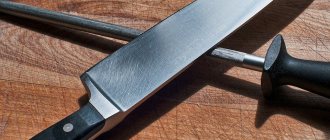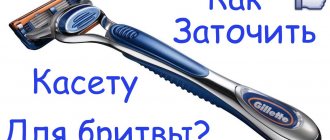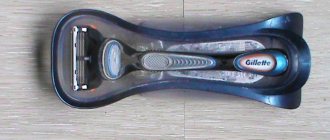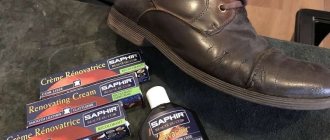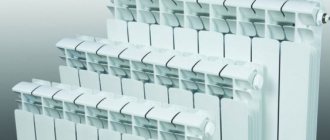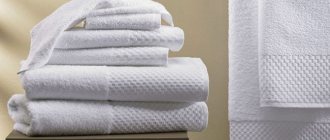In this article we will look at what and how to properly sharpen a knife at home, and also learn about the secrets of maintaining its sharpness.
Any knife, even a well-made and high-quality knife, becomes dull over time and ceases to be as sharp as in the first days after purchase. The cutting coating on the knife blade wears off after several years of use, which causes a lot of inconvenience. And a blunt object can cause injuries and cuts, because it slips much more often. Therefore, in this material you will learn how to reliably and quickly sharpen a knife yourself.
Correct knife sharpening angle
When sharpening kitchen knives, it is important that the objects are in a certain position in relation to the work surface. To do this, you need to choose the correct sharpening angle.
This parameter depends on many factors, for example, the type and level of strength of the metal from which the blade is made, as well as the purpose for which this tool is used. So, the degree of sharpening for different types of knives:
- scalpel and razor blade - from 10 to 15 degrees;
- vegetable, meat and fish knives - from 15 to 20 degrees;
- other chef's utensils - from 20 to 25 degrees;
- hunting blades – 25–30 degrees.
It is important to choose the right sharpening angle; this is necessary to achieve the desired sharpness of the kitchen appliance.
Types of knives and their purpose
Modern classification divides knives into the following categories:
- Combat. They are bladed weapons and are in service with the army as an addition to firearms. They are not intended for free sale and use.
- Tourist. Available for purchase, not prohibited from wearing, the handle and sheath are usually made of synthetic materials.
- Hunting. They have a varied form and purpose of use: work on cutting up hunted game, skinning, arranging a hunting area. Some types require permission to purchase and carry.
- Foldable or collapsible. A very common type, loved by all age categories of people. As the name suggests, the blade folds and the cutting edge fits into the handle. Some types are equipped with clips for attaching to a belt or pocket.
- Multitool A folding multifunctional knife with a set of tools - indispensable for travel and repairs. The standard sample includes: a small and large blade, pliers, screwdrivers, wrenches, a ruler, a hook, and scissors.
- Special purpose. A tool used in certain branches of human activity: medicine (scalpel), diving, Ministry of Emergency Situations, gardening.
- Campers or bivouacs. They are quite large in size and weight. Designed for setting up a tourist camp and clearing the area of the recreation area from bushes and small trees. An example is a machete or kukri. In practice, they easily replace an ax, but at the same time, they remain knives.
- Mark or sports knife for throwing. It is all-metal, without a cutting edge, and is designed to hit a target with a hand throw.
- Kitchen. Used for cooking, they come in a variety of shapes, sizes, thicknesses and blade configurations.
- Dining rooms. They have a certain shape with a rounded tip of the blade, the main purpose is to make eating easier.
- For survival. Positioned as assistants in extreme conditions. They have a number of features: the presence of a compass, a hollow handle that can accommodate a survival kit (a lighter, a fishing line with a sinker and a hook, a thread and a needle, an antiseptic, an antibiotic).
What grit size is needed for sharpening knives?
When sharpening blades, special stones are used. Their surface is an abrasive consisting of grains of different sizes. The grain size of the stone depends on this indicator. Devices for adding spice are divided into the following groups:
- the most coarse-grained (especially coarse material);
- regular coarse-grained;
- medium grain;
- fine-grained (delicate abrasive);
- micro-grained (material of increased fineness).
How to sharpen a knife correctly? A good master knows that using only one type of stone is ineffective. According to the rules, sharpening is performed alternately, moving from coarse-grained and rough stones to delicate, thin stones.
Recommendations
When considering the question of how to sharpen knives on a sharpening machine, do not forget about safety precautions.
A machine, even the smallest one, poses quite a serious danger to humans.
Therefore, it is recommended to check several aspects before starting work.
- Clothes should not hang loose, have laces or other elements not tucked in. This is necessary to ensure that the machine does not accidentally snag a lace or, for example, a sleeve, as this can lead to harm to human health.
- You need to wear protective gloves when working. A standard requirement when working with virtually any tools and machines, gloves protect the skin of your hands from metal dust and shavings.
- It is necessary to wear safety glasses while working. Glasses protect your eyes from metal dust, shavings, and sparks.
A simple set of rules that will reduce the risk when working at the machine to a minimum.
How to sharpen knives on a sharpening machine
Using a machine is considered an effective way of sharpening, however, the mechanism is cumbersome, and for this reason not every home has it. But if you have the opportunity to use it to sharpen dull kitchen appliances, you should know some of the intricacies of this work:
- sharpening on the machine is carried out at high temperatures, so it is necessary to set the minimum number of revolutions so as not to damage the blade;
- the blade must be pressed tightly against the sharpening surface, and the movements when sharpening must be smooth;
- When the cutting surface is sharp, it is important to keep the part being sharpened at an angle of 25–30 degrees relative to the grinding wheel.
Please note that you will need a lot of time to work. In addition, those who do not have sufficient experience in this matter should not undertake sharpening on a machine.
Advantages and disadvantages
The serator cuts the material at different angles. It cuts well fibrous and layered materials, for example, ropes, cords, cables, nets, belts. Sharpening maintains sharpness longer compared to a regular blade. The teeth penetrate the surface of the material faster than a smooth edge. Using a serator, you can pry and remove elements that protect the surface that needs to be cut, for example, fish scales.
Such knives have high cutting efficiency; teeth of different sizes and heights reduce the contact area, while the pressure force increases with the same force. The length of the edge increases due to the curved line of the teeth and becomes longer than the length of the blade. The knives will cut even after the sides of the teeth have dulled due to their sharp edges. Although the cut will be torn, you can still cut the rope with such a tool.
Disadvantages include difficulty in sharpening. The sharpness of the blade needs to be restored with a file; certain skills are required in order for the edge to be workable.
It is difficult or impossible to cut anything with a serator; it is not intended for such operations. If you cut viscous material with it, this leads to rapid clogging of the teeth, which have to be cleaned. The serrated cut often turns out to be uneven, which, however, depends on the material and the ability to use the tool. Cutting hard fibers requires considerable effort.
A serrated knife can behave differently in the hands of a right-hander and a left-hander due to the specificity of one-sided sharpening.
When making a cut, the tool may tilt to the side. The longer the blade, the greater the evasion.
How to properly sharpen knives with sandpaper
If you have some experience and know how emery works, sharpening knives will not be difficult for you. So, when sharpening blades on sandpaper, adhere to the following rules:
- When applying the blade to the abrasive, you should not apply large mechanical forces;
- the trajectory of rotation of the abrasive should be in the direction from the butt to the edge;
- the knife on the emery is moved across the circle, smoothly moving from the handle of the device to the tip of the blade;
- When sharpening on both sides, you cannot change the angle of fixation of the blade, you just need to move it to the other side;
- At the end of the work, straighten the knife with a block, musat or sandpaper.
Of course, real craftsmen prefer sharpening by hand, which allows them to achieve maximum effect. But if we are not talking about giving the blade a scalpel sharpness, but simply making it quite sharp, using sandpaper will achieve decent results.
What is a serrator
What is a serrator? Good question. To which the fairly easy answer is that it is a sawtooth grind. The only thing that distinguishes it from a real hacksaw, in which the teeth are set slightly apart, is that the teeth are located in the same plane.
Accordingly, they have no wiring. The teeth themselves are not pointed, but slightly rounded and lie in the same plane. The sharpening of the teeth is asymmetrical relative to the blade.
There are also wave-shaped ones; they are also classified in this family. It is worth noting that blades are often found half with a blade and half with a serrator.
Both at the end of the blade and closer to the butt, and there is one completely with such an interesting sharpening. Many manufacturers are trying to interest the buyer so much that they do something unimaginable with blades.
Serrated knife sharpening.
Today, their variety is confusing, and it becomes difficult to judge the benefit and advisability of partially sharpening a blade in this way.
It happens that uninitiated people may confuse the serrator with a shock saw on some blades on the butt.
How to sharpen kitchen knives with a sharpener
Today you can purchase special devices for sharpening knives - these are blade sharpeners. These devices are either mechanical or electrical. If you are not very experienced or have not tried sharpening knives at all yourself, it is better to use the electric option.
This sharpener independently selects the sharpening angle, and is used to sharpen any type of household blade. The work is done like this:
- Set the required mode.
- Place the blade in a special hole.
- Apply a little pressure to create tight contact between the blade and the sharpening surface.
Once you follow these steps, you no longer have to worry about ruining your knife. The sharpener will do the work on its own, and you will get a wonderfully sharp blade. This is the best way to achieve the desired sharpness of a kitchen appliance at home.
Sharpeners
A universal device with a comfortable handle has several slots with installed abrasive wheels. The angle between them has already been selected, so using such a tool is easy. Simply insert the base of the blade into the socket and pull the knife towards you through it. The blade is sharpened on both sides at once, so you have to put in half as much effort.
The design of household electric sharpeners is similar to manual knife sharpeners, but the circles also rotate. Working with them goes much faster, however, the result is not always satisfactory. When using electric sharpeners, you should not keep the knife in the sharpening wheels for too long - five minutes will be enough for the thickest and hopelessly dull blade.
How to use a round disc knife sharpener
There are various devices for sharpening knives, including sharpeners with round discs. The difference is that the sharpening material in this case is a special rotating roller that grinds the cutting surface at an angle of 45 degrees.
The main advantage of such devices is that after sharpening there is no burr left on the blade, and the work is done simply. In addition, tools sharpened with roller sharpeners stay sharp much longer than with V-shaped tools.
Most often, such sharpeners are suitable not only for knives, but also for scissors.
- So first make sure you select a cavity to sharpen your knife.
- Take the sharpener in your left hand and the knife in your right.
- Place the knife blade in the area of the handle between the discs and forcefully draw it to the tip.
- Repeat the same thing several times.
- Be careful not to cut yourself.
Pros and cons of the blade
As mentioned above, it becomes quite difficult to name the pros and cons of such sharpening. Some manufacturers don't have problems in a certain area, but some do. Therefore, it is quite difficult to give a definite answer. All of the examples given should not be applied specifically to all blades.
In general, a serrated knife is highly valued in the kitchen, but it uses a wave-like sharpening throughout the blade. Cutting a fresh crispy loaf is not a problem with such a blade. But if you take a semi-serrater, the result may be different. This is a small example, once again proving that you cannot judge all knives at once.
Pros of sharpening
Professionals highlight more positive qualities than negative ones. Let's try to look at them more closely. Let's start with the pros:
- It is immediately worth noting the high productivity when cutting layered and fibrous materials;
- thanks to the bends of the serrator, the cutting surface relative to the blade itself increases;
- a knife with such sharpening keeps its sharpness for quite a long time, this will be useful for people who have gone far from civilization;
- defensive actions with a blade with such sharpening are quite effective;
- cutting certain materials does not require much effort;
- It is quite productive in the kitchen, great for cutting various foods and cleaning fish.
Here one should not lose sight of such an interesting point as the price of the knife and its manufacturer. If you buy a cheap fake, you may not have all these qualities, or they will only last for a couple of days.
Possible disadvantages
The word “possible” is very appropriate in this context. It was already said above that such qualities are not inherent in all blades with such sharpening. But we also need to say about the disadvantages:
- If the knife does become dull, it is quite difficult to sharpen it. This can be done by a special technician who has the necessary equipment;
- the edges of the cut will always be uneven, the trick with a sheet of paper will not work here;
- The blade requires careful care; after use, pieces of material may remain in the serrations.
Kitchen serrated knife.
Many sources also include the disadvantage that it will be difficult for left-handed people to wield such a blade. During the cut, the blade will move to the side. But now there are quite a lot of models on the market for people whose left hand is considered a working hand. So this should not be considered a disadvantage.
How to sharpen Damascus steel knives
Damascus steel knives have been popular at all times; they are considered the most durable, and their sharpness cannot be compared with anything else. But even this material tends to become dull.
It is important to know that no electric sharpeners can be used here, only manual processing is needed. When sharpening a Damascus steel knife, you must adhere to the following principles:
- First, determine the strength of the metal. This can be done by paying attention to the sharpening angle; the stronger the material, the sharper it will be.
- Use fine-grained abrasives, gradually moving to micro-coatings.
- Sharpen the blade only along the cutting surface.
- If there are nicks, the edge must be ground along its entire length.
- If the bevels need to be polished, this must be done before the cutting edge is sharpened. If you process an already sharpened blade, the tip may simply become rounded.
If you are not sure that you will do everything correctly, it is better not to risk it and contact a specialist.
A little history
But an interesting fact is that almost all sickles in the villages were sharpened in this way. Even if we turn to the Bronze Age, excavations prove that even then people made blades with a similar sharpening. But until the 20th century, no one made knives like this.
And only one master noticed that the sawtooth-sharpened blade copes with dense material better than usual. By changing the saw teeth and adapting them to the cutting part, he brought to life the first, modern serrated knife.
With such a blade you will never be able to make even cuts on paper, but it is not intended for this.
Why can't it take so long to sharpen it? The special sharpening raises many questions and attracts interest. Therefore, today we will try to reveal the small secrets hidden in the serrator.
Is it possible to sharpen a knife without a stone?
It happens that a knife needs urgent sharpening, but there are no suitable tools. But don’t worry, you can solve the problem in the following ways:
- sharpen a dull knife on the blade of another cutting device;
- sharpen on the raw edges of the bottom of a plate or mug;
- sand the blade with sandpaper, processing only one side;
- take any stone that you find on the street and sharpen it in the same way as you do with a whetstone.
This will allow you to briefly sharpen a dull device, but such methods cannot be called full-fledged sharpening. Remember that it is better to reserve these measures for extreme cases and not to use them constantly, otherwise the blades will quickly become unusable.
Stocking up on tools
To sharpen a knife yourself, you will need the following tools:
- Musat (steel) is used for straightening . It can be made of solid steel, ceramics, or have diamond coating. In shape it resembles a file with an oval or round cross-section of the working part. Metal dusters are magnetized and attract metal dust. Ceramics are lighter, but more fragile. Musates are not used if the blade hardness is less than 50 units. HRC or more than 60 units. H.R.C. In the first case, they remove too much material, and in the second, their use will not bring results. Such files are used for knives with the correct geometry.
- Sharpening stones are the main tool for sharpening . They come in different degrees of grain. To restore the correct angle and shape of the cutting edge, the coarsest stones are used, the thinnest ones are used for straightening and finishing. The sharpening stone should be no shorter than the blade, but better – one and a half times longer. In extreme cases, when there is no stone at hand, sandpaper is used.
- Special straightening devices are devices made of several metal or ceramic disks that are partially nested one inside the other. They are convenient because they do not require professional skills and are completely safe. They can quickly remove burrs on a knife, which makes it sharper, but at the same time dulls just as quickly.
Read also: The best sharpening machine for drills
How to sharpen a knife on a knife
What to do if the blade becomes dull and you don’t have a whetstone or an electric sharpener at hand? Sharpen your knife on your knife! Perform this procedure like this:
- apply the cutting surface of the dull blade to the back of another knife;
- take the tools so that you sharpen “from yourself”, that is, the cutting edges should be directed to the sides;
- perform 10-15 vigorous strokes, rubbing one blade against the other.
This will briefly “revive” a dull knife, however, such a procedure is not a full-fledged sharpening.
Design Features
Not a single knife with a straight blade can compare with a bread knife if the task is to cut a freshly baked loaf with a crispy crust and airy pulp, maintain the structure of the pulp and not crumble the product itself. The secret is in the sharp teeth - in a professional bread knife they are large or medium, the sharpening is wavy or serrated. Externally, the cutting edge resembles a miniature construction saw, but the teeth are located on the same straight line. This tool has other differences from more universal models:
- The lowered tip is in line with the cutting edge. There is no need for the piercing part of such a knife, and besides, it has quite sharp teeth on the blade.
- Large - The length of the blade should be longer than the loaf itself to best handle slicing and have enough "span".
- The presence of a rest for the index finger (at the base of the blade). This is necessary to prevent cuts during operation.
How to sharpen a knife to razor sharpness
Almost any blade can be given a razor sharpness. To achieve this, use one of the methods below:
- Treat the surface with GOI paste and a piece of genuine leather, after removing nicks using a fine-grained stone. Remember that you need to carry out finishing work, moving from the handle to the tip, without changing direction, and keep the blade at an angle.
- Grind down the edge until the serrations are fine, and then grind the other side of the blade in the same way. This will add some spice, but not for long.
- Use ceramics, for example, turn a plate upside down and sharpen the device on the untreated areas on the bottom that are not covered with glaze.
When working, be careful not to get injured in the form of a cut or damage the blade.
Fine tuning
Of course, any kitchen knife can be brought to surgical sharpness. To do this, you need to grind down one side of its blade until small nicks appear, and then smooth the edge by processing the other. Such sharpening, of course, will not last long, but at first the knife will cut almost any product. Blades are polished using various grinding materials that can be found in any home.
Ceramic polishes blades well if you choose a sufficiently rough surface. Turn the clay bowl upside down - there will usually be unglazed areas. It is along them that you need to move the blade to bring the knife to perfect condition.
For jewelry work on the blade, you will need a piece of genuine leather and polishing paste like GOI. The surface of the flap is saturated with it, and then the blade is polished. Before starting fine finishing, all visible nicks are removed from the edge using a fine-grained whetstone. Polishing is performed in one direction - from the base to the tip with the knife tilted diagonally.
How to sharpen a serrated knife
If you have serrated knives in your kitchen, then you need to know that these utensils cannot be sharpened with regular sharpeners. To make this version of the cutting surface sharp, you need to do the following:
- Prepare a special tool for serrated blades, namely a cone-shaped sharpening rod, preferably made of ceramic.
- Determine the side on which the beveled teeth are located and sharpen this part of the blade.
- Place the sharpening device at an angle to the beveled part of the blade.
- Sharpen each depression with several movements, moving the blade in the direction “away from you.”
- Remove the formed burrs using sandpaper or the same rod, but do not press on the surface, but act gently.
- Sharpen the smooth side of the blade with a suitable tool.
Remember not to use a rod to trim the serrated surfaces on the side of the blade where they are missing, otherwise you will ruin the knife.
Scope of application
The fruitfulness of a blade with a serrated blade is definitely quite high. With such a knife you can easily cut meat; for such purposes, some manufacturers specially produce knives and position them specifically for kitchen work.
Hiking, hunting and fishing are also quite often not complete without it. Convenient for cleaning fish and cutting carcasses. It is widely used in the field of sports tourism and diving.
This is explained by the fact that such sharpening of the blade can easily cut ropes, ropes, etc. When caught in a net underwater, a diver can easily cut it.
Quite often, employees of the Ministry of Emergency Situations and other rescue services are equipped with such blades. The handle is made of special plastic, and the blades of some models have a crescent shape. Even manufacturers have made a special line called “sling cutters”.
Rescue knife with serrated sharpening.
And they don’t stop there, they produce special knives and characterize them as a survival knife. Folding cases with this sharpening are also produced. Quite a wide range of applications, popularized by the serrated blade.
Rules for using a whetstone
To ensure the desired cutting qualities of the knife, the following recommendations should be taken into account:
- Soak the stone in water for 15 - 20 minutes;
- to work you need a table in a well-lit place or with a lamp;
- to prevent the stone from slipping and damaging the table covering, place a cloth or paper on the table;
- to visually determine the sharpening angle of the knife, the blade is applied to the sharpening stone;
- the blade being sharpened is directed away from you at the selected angle;
- with gentle pressure, a reciprocating movement is produced, simulating cutting off a thin film from a grindstone along its entire plane. In this case, the blade moves relative to the block from the handle to the tip and back;
- the selected sharpening angle is maintained during each stroke of the stone;
- the blade and stone are periodically moistened with water and cleaned;
- after 20 - 30 repetitions on both sides of the blade, the cutting edge is inspected. When sharpened with a razor, it is not visible to the naked eye;
- The sharpness of the blade is checked on a sheet of paper by cutting it from top to bottom. A sufficiently sharp blade cuts and does not tear paper.
Folk remedies for washing dishes - benefits, savings or a waste of time
Tips for quickly sharpening a blade using improvised tools
Stone
You can quickly sharpen a knife on a hike or on a picnic using an ordinary cobblestone. Use any stone lying on the ground instead of a whetstone and run the knife blade along its surface. You won't achieve razor sharpness, but you will return the knife to working condition.
Second knife
It is quite possible to sharpen two knives at once, without sharpening stones or tools. To do this, you need to take a knife in both hands and begin to sharpen the blade of one knife on the blade of the other. After 5-10 minutes of this work, the knives will become sharper than before.
Glass objects
The knife blade can be slightly sharpened on the rough edge of glass or ceramic objects. For example, on the bottom of a glass or the edge of a tile. The main thing is that the surface is rough.
Leather belt
A leather belt is more suitable for finishing and giving the knife blade a razor sharpness than for rough sharpening. But if there is nothing at hand except a belt, then you can try to sharpen the knife on it. To do this, you need to tighten the belt and start moving the blade along it; you may not achieve strong sharpness, but you will polish the knife to a shine.
By learning to sharpen knives and tools yourself, you will acquire a skill that will be useful to you throughout your life!
